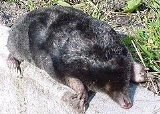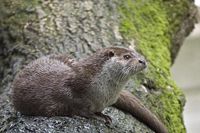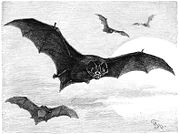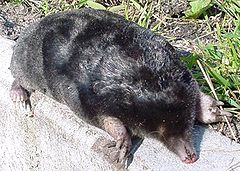
List of mammals of Andorra
Encyclopedia
This is a list of the mammal species recorded in Andorra. There are 17 mammal species in Andorra
, of which 0 are critically endangered, 0 are endangered, 2 are vulnerable, and 1 is near-threatened.
The following tags are used to highlight each species' conservation status as assessed by the IUCN
:
Some species were assessed using an earlier set of criteria. Species assessed using this system have the following instead of Near Threatened and Least Concern categories:
 The even-toed ungulates are ungulate
The even-toed ungulates are ungulate
s whose weight is borne about equally by the third and fourth toes, rather than mostly or entirely by the third as in perissodactyls. There are about 220 artiodactyl species, including many that are of great economic importance to human
s.
Order: Carnivora
----
.jpg)
 There are over 260 species of carnivorans, the majority of which feed primarily on meat. They have a characteristic skull shape and dentition.
There are over 260 species of carnivorans, the majority of which feed primarily on meat. They have a characteristic skull shape and dentition.
 The bats' most distinguishing feature is that their forelimbs are developed as wings, making them the only mammals in the world naturally capable of flight. Bat species account for about 20% of all mammals.
The bats' most distinguishing feature is that their forelimbs are developed as wings, making them the only mammals in the world naturally capable of flight. Bat species account for about 20% of all mammals.
Order: Lagomorpha
----
Order: Rodent
----
Rodents make up the largest order of mammals, with over 40 percent of mammalian species. They have two incisor
s in the upper and lower jaw which grow continually and must be kept short by gnawing. Most rodents are small though the capybara
can weigh up to 45 kg (100 lb).
Order: Soricomorpha
----
 The "shrew-forms" are insectivorous mammals. The shrews and soledons closely resemble mice while the moles are stout bodied burrowers.
The "shrew-forms" are insectivorous mammals. The shrews and soledons closely resemble mice while the moles are stout bodied burrowers.
Andorra
Andorra , officially the Principality of Andorra , also called the Principality of the Valleys of Andorra, , is a small landlocked country in southwestern Europe, located in the eastern Pyrenees mountains and bordered by Spain and France. It is the sixth smallest nation in Europe having an area of...
, of which 0 are critically endangered, 0 are endangered, 2 are vulnerable, and 1 is near-threatened.
The following tags are used to highlight each species' conservation status as assessed by the IUCN
World Conservation Union
The International Union for Conservation of Nature and Natural Resources is an international organization dedicated to finding "pragmatic solutions to our most pressing environment and development challenges." The organization publishes the IUCN Red List, compiling information from a network of...
:
| EX | Extinct | No reasonable doubt that the last individual has died. |
| EW | Extinct in the wild | Known only to survive in captivity or as a naturalized populations well outside its previous range. |
| CR | Critically Endangered | The species is in imminent risk of extinction in the wild. |
| EN | Endangered | The species is facing an extremely high risk of extinction in the wild. |
| VU | Vulnerable | The species is facing a high risk of extinction in the wild. |
| NT | Near Threatened | The species does not meet any of the criteria that would categorise it as risking extinction but it is likely to do so in the future. |
| LC | Least Concern | There are no current identifiable risks to the species. |
| DD | Data Deficient | There is inadequate information to make an assessment of the risks to this species. |
Some species were assessed using an earlier set of criteria. Species assessed using this system have the following instead of Near Threatened and Least Concern categories:
| LR/cd | Lower Risk/conservation dependent | Species which were the focus of conservation programmes and may have moved into a higher risk category if that programme was discontinued. |
| LR/nt | Lower Risk/near threatened | Species which are close to being classified as Vulnerable but are not the subject of conservation programmes. |
| LR/lc | Lower Risk/least concern | Species for which there are no identifiable risks. |
Order: Artiodactyla (even-toed ungulates)
----
Ungulate
Ungulates are several groups of mammals, most of which use the tips of their toes, usually hoofed, to sustain their whole body weight while moving. They make up several orders of mammals, of which six to eight survive...
s whose weight is borne about equally by the third and fourth toes, rather than mostly or entirely by the third as in perissodactyls. There are about 220 artiodactyl species, including many that are of great economic importance to human
Human
Humans are the only living species in the Homo genus...
s.
- Family: SuidaeSuidaeSuidae is the biological family to which pigs belong. In addition to numerous fossil species, up to sixteen extant species are currently recognized, classified into between four and eight genera...
(pigs)- Subfamily: SuinaeSuinaeSuinae is a subfamily of mammals that includes at least some of the living members of the family Suidae and their closest relatives—the domestic pig and related species, such as babirusas. Several extinct species within Suidae are classified in subfamilies other than Suinae...
- Genus: Sus
- BoarBoarWild boar, also wild pig, is a species of the pig genus Sus, part of the biological family Suidae. The species includes many subspecies. It is the wild ancestor of the domestic pig, an animal with which it freely hybridises...
Sus scrofa LR/lc
- Boar
- Genus: Sus
- Subfamily: Suinae
- Family: Cervidae (deer)
- Subfamily: CapreolinaeCapreolinaeCapreolinae, also known as Odocoileinae or the New World deer , is a subfamily of deer...
- Genus: CapreolusCapreolusCapreolus is a genus of deer with at least two extant species:* Capreolus capreolus * Capreolus pygargus...
- Roe DeerRoe DeerThe European Roe Deer , also known as the Western Roe Deer, chevreuil or just Roe Deer, is a Eurasian species of deer. It is relatively small, reddish and grey-brown, and well-adapted to cold environments. Roe Deer are widespread in Western Europe, from the Mediterranean to Scandinavia, and from...
Capreolus capreolus LR/lc
- Roe Deer
- Genus: Capreolus
- Subfamily: Capreolinae
Order: CarnivoraCarnivoraThe diverse order Carnivora |Latin]] carō "flesh", + vorāre "to devour") includes over 260 species of placental mammals. Its members are formally referred to as carnivorans, while the word "carnivore" can refer to any meat-eating animal...
(carnivorans)
----.jpg)

- Suborder: CaniformiaCaniformiaCaniformia, or Canoidea , is a suborder within the order Carnivora. They typically possess a long snout and non-retractile claws . The Pinnipedia evolved from caniform ancestors and are accordingly assigned to this group...
- Family: CanidaeCanidaeCanidae is the biological family of carnivorous and omnivorous mammals that includes wolves, foxes, jackals, coyotes, and domestic dogs. A member of this family is called a canid . The Canidae family is divided into two tribes: Canini and Vulpini...
(dogs, foxes)- Genus: VulpesVulpesVulpes is a genus of the Canidae family. Its members are referred to as 'true foxes', although there are species in other genera whose common names include the word 'fox'....
- Red FoxRed FoxThe red fox is the largest of the true foxes, as well as being the most geographically spread member of the Carnivora, being distributed across the entire northern hemisphere from the Arctic Circle to North Africa, Central America, and the steppes of Asia...
Vulpes vulpes LC
- Red Fox
- Genus: Vulpes
- Family: MustelidaeMustelidaeMustelidae , commonly referred to as the weasel family, are a family of carnivorous mammals. Mustelids are diverse and the largest family in the order Carnivora, at least partly because in the past it has been a catch-all category for many early or poorly differentiated taxa...
(mustelids – weasels and stoats)- Genus: Mustela
- Least WeaselLeast WeaselThe least weasel is the smallest member of the Mustelidae , native to Eurasia, North America and North Africa, though it has been introduced elsewhere. It is classed as Least Concern by the IUCN, due to its wide distribution and presumably large population...
Mustela nivalis LR/lc - European PolecatEuropean polecatThe European polecat , also known as the black or forest polecat , is a species of Mustelid native to western Eurasia and North Africa, which is classed by the IUCN as Least Concern due to its wide range and large numbers. It is of a generally dark brown colour, with a pale underbelly and a dark...
Mustela putorius LR/lc - StoatStoatThe stoat , also known as the ermine or short-tailed weasel, is a species of Mustelid native to Eurasia and North America, distinguished from the least weasel by its larger size and longer tail with a prominent black tip...
Mustela erminea LC
- Least Weasel
- Genus: LutraLutraLutra is a genus of otters.*Lutra nippon - Japanese otter*Lutra sumatrana - Hairy-nosed otter*Lutra lutra - European otter-Habitat:Lutra are semi-aquatic mammals and therefore need to be well-adapted to both water and land...
- European OtterEuropean OtterThe European Otter , also known as the Eurasian otter, Eurasian river otter, common otter and Old World otter, is a European and Asian member of the Lutrinae or otter subfamily, and is typical of freshwater otters....
Lutra lutra NT
- European Otter
- Genus: Mustela
- Family: Ursidae (bears)
- Genus: UrsusUrsus (genus)Ursus is a genus in the family Ursidae that includes the widely distributed brown bears, the polar bear, and black bears. The name is derived from the Latin ursus, meaning bear.-Species and subspecies of Ursus:...
- Eurasian Brown BearEurasian Brown BearThe Eurasian brown bear is a subspecies of brown bear, found across northern Eurasia. The Eurasian brown bear is also known as the common brown bear, European brown bear and colloquially by many other names....
Ursus arctos arctos CR
- Eurasian Brown Bear
- Genus: Ursus
- Family: Canidae
Order: Chiroptera (bats)
----
- Family: Vespertilionidae
- Subfamily: Myotinae
- Genus: Myotis
- Greater Mouse-eared BatGreater mouse-eared batThe greater mouse-eared bat, Myotis myotis, is a European species of bat in the Vespertilionidae family.-Description:It is relatively large for a member of the Myotis genus, weighing up to , making it one of the largest European bats.-Foraging:Like its relatives it eats various arthropods;...
Myotis myotis LR/nt
- Greater Mouse-eared Bat
- Genus: Myotis
- Subfamily: VespertilioninaeVespertilioninaeVespertilioninae is a subfamily of Vesper Bats from the family Vespertilionidae.-Classification:Subfamily Vespertilioninae*Tribe Eptesicini**Genus Arielulus***Collared Pipistrelle, Arielulus aureocollaris...
- Genus: BarbastellaBarbastellaBarbastella is a small genus of vespertilionid bats. There are three described species in this genus.-Species:Barbastella is a small genus of vespertilionid bats. There are three described species in this genus.-Species:...
- BarbastelleBarbastelleThe Barbastelle , also known as the Western Barbastelle, is a European bat. It has a short nose, small eyes and wide ears.It is rare throughout its range...
Barbastella barbastellus VU
- Barbastelle
- Genus: NyctalusNyctalusThe bat genus Nyctalus are members of the family Vespertilionidae or sometimes Evening bats. They are distributed in the temperate and subtropical areas of Europe, Asia and North Africa.There are eight species within this genus:...
- Lesser NoctuleLesser NoctuleThe Lesser Noctule or Leisler's Bat is a species of bat belonging to the vesper bat family, Vespertilionidae.-Description:...
Nyctalus leisleri LR/nt
- Lesser Noctule
- Genus: Barbastella
- Subfamily: Myotinae
- Family: Rhinolophidae
- Subfamily: Rhinolophinae
- Genus: Rhinolophus
- Lesser horseshoe batLesser horseshoe batThe Lesser Horseshoe Bat , is a type of European bat related to but smaller than its cousin, the Greater Horseshoe Bat...
Rhinolophus hipposideros LC
- Lesser horseshoe bat
- Genus: Rhinolophus
- Subfamily: Rhinolophinae
Order: LagomorphaLagomorphaThe lagomorphs are the members of the taxonomic order Lagomorpha, of which there are two living families, the Leporidae , and the Ochotonidae...
(hares and rabbits)
----- Family: LeporidaeLeporidaeLeporids are the approximately 50 species of rabbits and hares which form the family Leporidae. The leporids, together with the pikas, constitute the mammalian order Lagomorpha. Leporids differ from pikas in having short furry tails, and elongated ears and hind legs...
- Subfamily:
- Genus: LepusLepusLepus is the genus of hares.Lepus may also be:* Lepus , a group of stars* Arieşeni, a commune in Romania* Lepus-the story of a hare, a book by D.Brian Plummer...
- European RabbitEuropean RabbitThe European Rabbit or Common Rabbit is a species of rabbit native to south west Europe and north west Africa . It has been widely introduced elsewhere often with devastating effects on local biodiversity...
Oryctolagus cuniculus VU (in Spain), NT (in rest of Europe including Portugal) - European HareEuropean HareThe European hare , also known as the brown hare, Eastern Jackrabbit and Eastern prairie hare, is a species of hare native to northern, central, and western Europe and western Asia. It is a mammal adapted to temperate open country. It is related to the similarly appearing rabbit, which is in the...
Lepus europaeus LR/lc
- European Rabbit
- Genus: Lepus
- Subfamily:
Order: RodentRodentRodentia is an order of mammals also known as rodents, characterised by two continuously growing incisors in the upper and lower jaws which must be kept short by gnawing....
ia (rodents)
----Rodents make up the largest order of mammals, with over 40 percent of mammalian species. They have two incisor
Incisor
Incisors are the first kind of tooth in heterodont mammals. They are located in the premaxilla above and mandible below.-Function:...
s in the upper and lower jaw which grow continually and must be kept short by gnawing. Most rodents are small though the capybara
Capybara
The capybara , also known as capivara in Portuguese, and capibara, chigüire in Venezuela, Colombia, and Ecuador ronsoco in Peru, chigüiro, and carpincho in Spanish, is the largest living rodent in the world. Its closest relatives are agouti, chinchillas, coyphillas, and guinea pigs...
can weigh up to 45 kg (100 lb).
- Suborder: MyomorphaMyomorphaSuborder Myomorpha contains 1,137 species of mouse-like rodents, nearly a quarter of all mammal species. Included are mice, rats, gerbils, hamsters, lemmings and voles. They are grouped according to the structure of the jaw and the structure of the molar teeth. Both their medial and lateral...
- Family: CricetidaeCricetidaeThe Cricetidae are a family of rodents in the large and complex superfamily Muroidea. It includes true hamsters, voles, lemmings, and New World rats and mice...
- Subfamily: ArvicolinaeArvicolinaeThe Arvicolinae are a subfamily of rodents that includes the voles, lemmings, and muskrats. They are most closely related to the other subfamilies in the Cricetidae . Some authorities place the subfamily Arvicolinae in the family Muridae along with all other members of the superfamily Muroidea...
- Genus: ArvicolaArvicolaThe water voles are large voles in the genus Arvicola. They are found in both aquatic and dry habitat through Europe and much of northern Asia...
- Water Vole Arvicola terrestris LR/lc
- Genus: MicrotusMicrotusThe genus Microtus is a group of voles found in North America, Europe and northern Asia. The genus name refers to the small ears of these animals. There are 62 species in the genus....
- Field VoleField VoleThe field vole or short-tailed vole, Microtus agrestis, is a grey-brown vole, around 110mm in length, with only a short tail. They are one of the most common mammals in Europe, ranging from the Atlantic coast to Lake Baikal. They are found in moist grassy habitats, such as woodland, marsh, or...
Microtus agrestis LR/lc - Common VoleCommon VoleThe Common Vole, Microtus arvalis, is a European mammal.- Distribution and habitat :The common vole is hardly restricted in means of distribution and habitat and inhabits large areas of Eurasia. As Microtus arvalis followed human civilisation, primary and secondary habitats can be distinguished...
Microtus arvalis LR/lc
- Field Vole
- Genus: Arvicola
- Subfamily: Arvicolinae
- Family: MuridaeMuridaeMuridae is the largest family of mammals. It contains over 600 species found naturally throughout Eurasia, Africa, and Australia. They have been introduced worldwide. The group includes true mice and rats, gerbils, and relatives....
(mice, rats, gerbils, etc.)- Subfamily: MurinaeMurinaeThe Old World rats and mice, part of the subfamily Murinae in the family Muridae, comprise at least 519 species. This subfamily is larger than all mammal families except the Cricetidae and Muridae, and is larger than all mammal orders except the bats and the remainder of the...
- Genus: ApodemusApodemusApodemus is the genus of Muridae which contains the Eurasian field mice. Related to the Ryūkyū spiny rats and the prehistoric Rhagamys – and far more distantly to Mus and Malacomys –, it includes the following species:*Striped Field Mouse, Apodemus agrarius*Alpine Field Mouse, Apodemus...
- Yellow-necked MouseYellow-necked mouseThe Yellow-necked Mouse Apodemus flavicollis is closely related to the wood mouse, with which it was long confused, only being recognised as a separate species in 1894. It differs in its band of yellow fur around the neck and in having slightly larger ears and usually being slightly larger overall....
Apodemus flavicollis LR/lc - Wood mouseWood mouseThe wood mouse is a common murid rodent from Europe and northwestern Africa. It is closely related to the yellow-necked mouse but differs in that it has no band of yellow fur around the neck, has slightly smaller ears, and is usually slightly smaller overall: around 90 mm in length...
Apodemus sylvaticus LC
- Yellow-necked Mouse
- Genus: Apodemus
- Subfamily: Murinae
- Family: Cricetidae
Order: SoricomorphaSoricomorphaThe order Soricomorpha is taxon within the class of mammals. In previous years it formed a significant group within the former order Insectivora...
(shrews, moles, and soledons)
----
- Family: TalpidaeTalpidaeThe family Talpidae includes the moles, shrew moles, desmans, and other intermediate forms of small insectivorous mammals of the order Soricomorpha...
(moles)- Subfamily: TalpinaeTalpinaeThe subfamily Talpinae, sometimes called "Old World moles" or "Old World moles and relatives", is one of three subfamilies of the mole family Talpidae, the others being the Scalopinae, or New World moles, and the Uropsilinae, or shrew-like moles....
- Tribe: Desmanini
- Genus: Galemys
- Pyrenean DesmanPyrenean DesmanThe Pyrenean Desman is a small semi-aquatic mammal that lives in the Pyrenees to the Iberian peninsula. The Pyrenean Desman is in the monotypic genus Galemys. The Pyrenean Desman lives in mountain streams....
Galemys pyrenaicus VU
- Pyrenean Desman
- Genus: Galemys
- Tribe: TalpiniTalpiniTalpini is a tribe, in the scientific classification system of binomial nomenclature. It encapsulates a group of mammals known as Old World Moles. It is a division of the subfamily Talpinae.-References:* Animal Diversity Web * Blackwell Synergy...
- Genus: Talpa
- European MoleEuropean MoleThe European Mole, Talpa europaea, is a mammal of the order Soricomorpha. It is also known as the Common Mole and the Northern Mole....
Talpa europaea LR/lc
- European Mole
- Genus: Talpa
- Tribe: Desmanini
- Subfamily: Talpinae
See also
- List of chordate orders
- List of regional mammals lists
- List of prehistoric mammals
- Mammal classificationMammal classificationMammalia is a class of animal within the Phylum Chordata. Mammal classification has been through several iterations since Carolus Linnaeus initially defined the class. Many earlier ideas have been completely abandoned by modern taxonomists, among these are the idea that bats are related to birds...
- New mammal species

